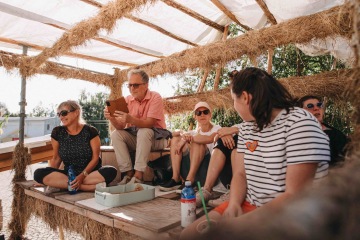Survival Hotspot - The Parliament of Fowls
The Parliament of Fowls was an interactive temporary installation in a public space in the Šumava housing estate. In the open area (or square?), the work of art was installed in the middle of the estate for the whole summer of 2023. How did it perform its function? What questions did it raise? How did it succeed in fulfilling its purpose?
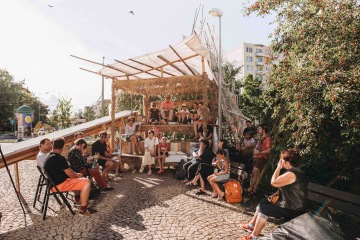
The installation called Parliament of Fowls was part of the first implementation in the Survival Hotspots project. The aim of the project is to connect the general public with modern art and contemporary architecture. A series of site-specific installations in various public spaces in České Budějovice should increase the awareness of the population about the importance of public space in their immediate surroundings and raise the issue of adapting the city's environment in times of climate change.
The sites selected by the artists for the installation are based on the suggestions received from the socio-urban workshops held during the Kul.turistic stops in the previous year, and from the residents themselves, and from interviews with them - from the needs and demands of the residents themselves and of the local organizations, and groups, or institutions. The challenge for the creators of current and future installations is to choose a place that invites discussion. A place where together with the locals, or the locals themselves can raise questions such as "Who are we, the inhabitants of this place?", "What is worth the effort in this environment?", "How is life here and how will it be in 10 or 20 years?". The interventions are designed to consider the global environmental crisis and its local manifestations.
The ideas that gave rise to the shape and form of the first such installation - the Parliament of Fowls - were evaluated together at the dernissage on 17 September. In a discussion between the people who took care of the installation and realised it, together with its authors, we explored its impact. And whether and how it fulfilled its purpose. Whether it managed to visibly carry the ideas that it was based on. And whether it has made any change to the place and public space in which it was installed.
The whole process was witnessed by members of the Socionaut Studio who collected feedback from locals on the last day of the Parliament of Fowls's installation, helping significantly with the whole reflection.
What should the Parliament of Fowls be like?
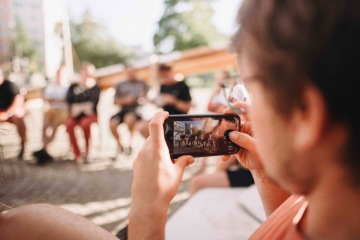
The authors of the architectural installation were Jan Fabián, sculptor and architect and Matouš Lipus, sculptor and Jiří Ptáček, contemporary art curator. Their main objectives were to create a place for (social) gathering and provide a shelter and a water feature for the locals. To breathe new life and impulses into a place that stands a bit apart.
It was supposed to ask people questions like: Do we miss the shade here? Do we want water here, a place to rest...?
The environment of the Parliament of Fowls was meant to inspire a common discussion about the future shape of the place, and at the same time to remind the local human community of the presence of other neighbours - whether animal or plant - to create temporary conditions for their good coexistence.
Place and coexistence
A square that is not really a square, but rather an open space. Without a name, yet the centre for the whole Šumava housing estate. In all the surveys, people primarily appreciated the services and the proximity to green spaces. However, they lacked social activities, more places to meet, and opportunities to spend time in the green.
The installation connected the square with the park zone, which had only been ornamental until then. Children watched the bugs, adults lay in the grass and watched the sky and the birds.
Gathering
Ptačí sněm vybízel k pozorování okolí. Na jinak klidném místě se “něco dělo”. Pohodlí instalace vybízelo ke spočinutí.
Ukázal, že malé herní prvky a drobné zásahy do veřejného prostoru na různých místech umožňující lidem se zastavit a trávit (společně s dětmi) na místě chvíli času. Jsou tak skvělou příležitostí k využívání veřejného prostoru.
Jednoduchým způsobem jak zabydlovat veřejný prostor by mohl být i promyšlený městský mobiliář. Úvaha nad jeho rozmístěním a s ním spojená hravost vybízí třeba i k hledání různých funkcí a možností jeho využívání. I to do veřejného prostoru přináší život, vybízí ke spočinutí, vytváří příležitost pro rozhovor i mezigenerační setkávání.
Intervence také otevřela otázku celkové ochoty setkávat se. Ukázalo se, že ta nepřichází sama, je nutné pro ni vytvářet příležitosti. Aby se spíše vylidněný prostor zaplnil činností a programem, je nutná aktivita lidí.
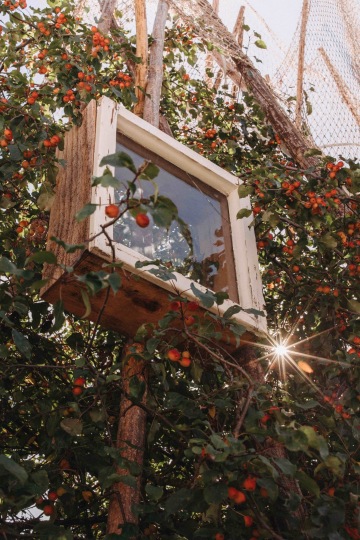
Místo s nejasnou budoucností
Co by tedy mělo na místě stát? Co by mělo na místě být, aby co nejlépe sloužilo místním obyvatelům? Odpověď není jednoduchá.
Budova přiléhající k náměstí patří soukromému majiteli, město je tudíž značně omezeno při plánování budoucí podoby tohoto prostoru. Ten nyní nabízí místním jedinou občanskou vybavenost a lidé se obávají jejich ztráty. Vize změny zatím, podle města, není. Ani plány na jeho budoucí podobu.
Ptačí sněm poskytl ale příležitost zamyslet se - a to jak místním obyvatelům, tak politické reprezentaci – nad tím, co by si na místě oni sami přáli.
Jméno, které místo zatím nemá, pak možná přijde s novou funkcí a přirozenou transformací, které veřejný prostor povýší na novou úroveň a dají místu podobu a třeba i ono chybějící jméno.
Timing
The timing of implementation proved to be the major challenge. The installation was supposed to offer additional leisure opportunities during holidays, yet the shelter did not come to life as we would have liked. The communities and institutions that could used it are closed over the summer, or do not function and work, with potential individuals - otherwise part of the communities and institutions - living temporarily in other places, outside the estate. Thus, the "active people" were missing. The programme was therefore delivered more than was originally expected 'from outside', rather than created by the local community. It was also surprisingly challenging to maintain the artwork, which was originally supposed to involve more local people (residents, organisations and institutions). In the future, we would like to see more collaboration on the object and its contents so it "belonged" more to the local community.
Water slide and shelter
Nevertheless – because of the holidays and warm weather - the shelter and especially the water feature proved to be a beautiful feature that was used every day especially by children and teenagers.
The installation was an improvised playground for the children. They would climb on it and slide into the water. It was playful and interactive and enticed them to explore.
A water element in a public space is always favourably received. And although, in the case of the Parliament of Fowls, it was not originally intended exclusively for children, but for plants and birds, it was the most appreciated part of the whole installation.
Many people also applauded the practical dimension of the piece as it offered shelter from the rain and provided shade.
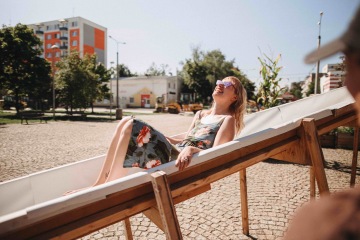
The appearance of the Parliament of Fowls
Perhaps the most controversial point was the external appearance of the installation. There were diverse, even contradictory opinions.
As a rule, it was fully accepted and understood and actively used (sliding, bathing, sitting or climbing on it) by children who are more open in their perception. The younger residents of the housing estate considered the Parliament of Fowls as "an interesting element to enliven the public space", appreciating its originality and playfulness. However, the majority of residents interviewed did not like the artwork. They considered it 'inappropriate'. They were unsure of the context and 'it did not fit the place' according to them. The intervention was illegible to them. It aroused suspicion and uncertainty, and they were unwilling to step into an unfamiliar zone.
Audience
Here we are on the edge of good taste pushing the perception of the majority audience. It is obvious that the provocative look, the recycled materials, the imperfect surface do not match the current idea of "representative" art in an urban environment.
For a large number of people the installation was incomprehensible, they did not understand its functions, they did not see its practical benefit. They did not know how they should use it and how it could help the environment. The uncertainty of something unconventional and new won't allow the residents to interact, it won't allow them to appropriate the object, and it's easy to slip into resentment - it's safer to stay in this zone, especially if there are more of them.
And while the youngest residents of the estate appreciate the furniture that allows for creative leisure, middle-aged and older residents are hesitant, finding their way to it more slowly, or not at all. And such a thing is more likely to put them off.
Communication
Better and more thorough communication can be the key to overcome this barrier. Each time the creators managed to establish a closer contact with the locals and spark a conversation, they would usually change their attitude. Distance, reservation and rejection slowly turned into understanding. The residents began to identify themselves with the functions of the artwork. They began to understand it and all of a sudden, its form and shape became more meaningful.
Next time, if a deeper contact could be made with the locals (perhaps using their close communication channels, or through a mediator) to involve them in the preparatory stages during the creation of the artwork, it would lead to a much greater acceptance, even enthusiasm for its purpose and the actual animation of the artwork.
The organization of more semi-formal and informal meetings in the vicinity could certainly help in the future. Or, the artwork being used by local organisations and institutions.
The Parliament of Fowls continues to raise questions
What should an artwork in a public space look like? What functions should it perform? Should it only respond to the needs of local residents and be 'bespoke' so to speak? Are well-functioning communities dependent on the possibility to meet somewhere?
The installation certainly raised a discussion about what art in public space should and could look like. It disrupted to some extent the conservative perception of its form. We strive for an open society and audience. And we want to push its limits. The reactions on social media can be seen as a disruption to existing boundaries. Just the fact that the installation has survived in a very good condition proves that it has to some extent jumped to the front of the line. And in doing so, it pushes the boundaries of good taste.
The negative reactions were only about the external appearance of the Parliament of Fowls, not about the occupation of the space and its function. A few people even appreciated the fact that it looked unconventional and different from artworks commonly seen in public spaces. The presence and possibility of watching fauna and flora, the sensitization to other residents, the possibility of conversation, and intergenerational encounter, or the use of water... All these are moments that satisfy the needs of local residents.
And while the artwork may be incomprehensible and symbolically remote for many, such an intervention offering a varied and playful furniture in a place that lacks, for example, a shaded seating area or a water feature, may attract many people. A discussion of the work and art - even a critical one - can then follow.
It is important to encourage openness towards the use of public space. And the subsequent dialogue with the artist and creator of the artwork can also help.
Local residents should be heard and they should be informed about upcoming changes and have a chance to share in decision-making, they should have a space to meet in order to discuss and to occupy the public space. And so, in the future they can much better unite into a strong community.
A confident and strong community can benefit much more from future interventions in public space. In the future, they can collaborate and co-create to populate it and the whole space.
The artist who will create the next artwork will have the opportunity to improve communication (talking to local people, providing explanations, and clarifying the intention, or asking for opinions) to include them in the whole process of the creation and existence of the artwork.
